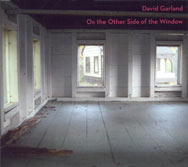David
Garland
On
The Other Side Of The Window
(Review Records)
An
album that sounds fresh and whose recorded sound is intelligently musical,
and where a very high pleasure quotient does not signal for once a low
IQ in the musical ideas dept. (and of how many current albums can one
say the same?), On The Other Side Of The Window gets my personal prize
for "surprise album of the year". Under a plain, conversational
tone (of which Garland's voice is no little part), the songs hide quite
a few irregular developments and many beautiful melodic ideas that one
really gets only after repeated listening. And if the vocals occupy
center stage, this is not at the expense of unusual or even bizarre
(but never gratuitous) musical touches: when was the last time you've
heard on record not only vibes and ocarina, but bowed psaltery, electric
basses through a wha-wha pedal, and mysterious thingees such as the "Taliesen
quartzite"?
I have to confess that I had totally forgotten about David Garland. I
had listened to an album of his songs titled Control Songs, in 1986,
and then to The Worlds Of Love (1989), his collaboration with Ikue Mori
and Cinnie Cole which was re-released on CD three years ago; while I
have never managed to listen to I Guess I Wasn't Made For These Times,
his album of arrangements of songs by Brian Wilson of the Beach Boys
which was only released in Japan. I don't know whether Garland's later
works were particularly hard to find or if my liking of his previous
albums had been on the tepid side (he is also a much-appreciated radio
dj in New York City - in fact, he's been at it for twenty years!).
It's plainly obvious that Garland has worked a lot on the material that's
on the album, with a lot of patience and skill - just listen to the
way everything "magically" appears to be in the right place.
His compositions sound highly personal - they may remind you of many
things while sounding like nothing else (I imagined listening to the
miniature called Tea Time (Secular Prayer #4) as sung by Kevin Ayers,
circa 1974). Many musical inventions in the melodies and in the arrangements
- listen to those unconventional timbres! - reminded me of a dimension
of pleasant classicism, with a few nods in the general direction of
the Sixties. The lyrics are never banal, in fact they are quite stimulating
- but they are not included on the CD (why?), just like the line-up
for each song; but one can read everything by accessing Garland's official
website.
Opening
the CD, the title-track is a good introduction to the work: an instrumental
intro which doesn't hurry, some hyper realistic timbres - the inside
of a piano - the vocal narration, the contrapuntal background vocals.
I bet that How To, whose nice melodic dialogue was "custom made
for the voice and harmonica of Karen Mantler", will become the
favourite track for many. While Garland plays most instruments quite
well, guest musicians add appropriate instrumental touches - check Meredith
Yayanos's violin on Distance and Phantom Limb and Ron Horton's trumpet
and flugelhorn on Out Here and Grip. There are also some "field
recordings" such as the vocal lines in I'm Here (Secular Prayer
#1) and the closing ("ambient") track called Pastorale. I
personally liked the directness of Good Design and the varied atmosphere
of Distance, Phantom Limb and Self Portrait. Also noteworthy is Out
Here, with its somewhat "old-fashioned" air, sung by Michael
"Sport" Murphy.
On
The Other Side Of The Window is an album that works beautifully as a
whole while at the same time letting the listener choose his/her own
favourite route. It's an album that maybe can appear to be "small"
but whose humanistic approach - which can be regarded as anachronistic,
given the present times - is a much-needed breath of fresh air for this
very same reason.
Beppe
Colli
©
Beppe Colli 2004
CloudsandClocks.net
| Jan. 3, 2004











